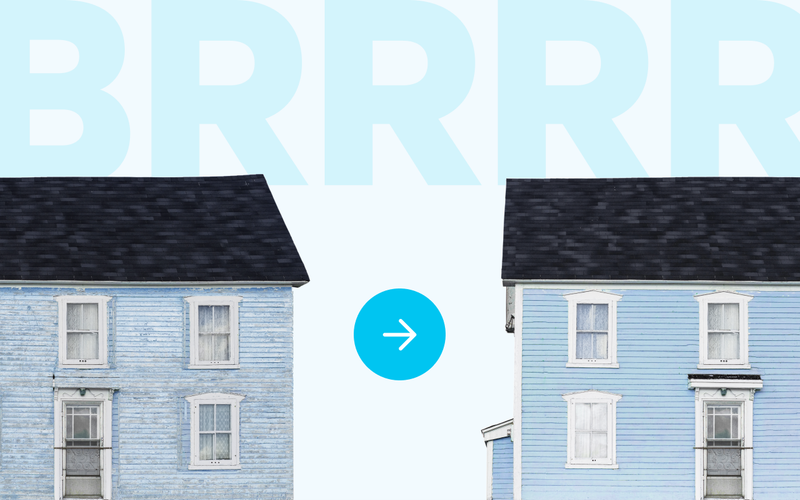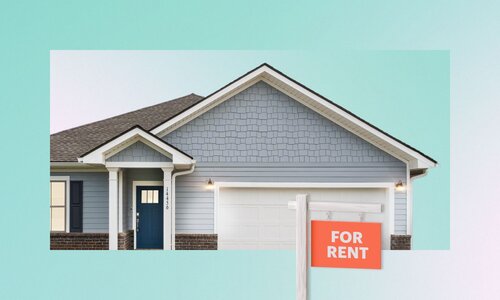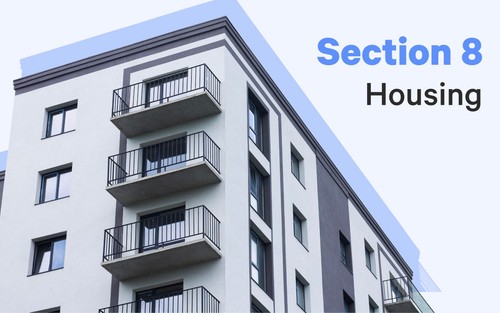The BRRRR method is a real estate investing strategy that can be very lucrative for seasoned investors. But, like all investments, it’s not without risks.
If you’re considering a BRRRR strategy, this article is for you. Use it as a guide to help determine if the BRRRR method suits you.
What is the BRRRR method?
The BRRRR method is a real estate investing strategy. BRRRR is an acronym for Buy, Rehab, Rent, Refinance, Repeat.
Investors purchase properties that need renovations. They rehab them and rent them out. Then, after they’ve built up equity, they do a cash-out refinance to use their profit on another property.
The BRRRR strategy may seem like a form of house flipping, but it’s pretty different.
Like BRRRR, house flipping is a type of real estate investment strategy in which the investor buys a distressed property and rehabs it to add value. However, house flippers turn around and sell the property for its higher after-rehab value to earn a profit. BRRRR investors keep their properties to build equity. They use that equity to buy more properties.
The BRRRR method is a complex real estate investment strategy that requires a deep knowledge of the real estate industry and financing processes. As a result, it’s not a reasonable investment strategy for beginners.
The 5 steps of BRRRR
BRRRR stands for Buy, Rehab, Rent, Refinance, Repeat. They’re essentially the steps of the BRRRR strategy. Let’s take a closer look at them.
Buy
The key to success and profit using the BRRRR method is buying an investment property at a discounted price with a reasonable interest rate. Investors focus on distressed properties that most homebuyers don’t want. These properties typically need renovations and upgrades and are listed for below-average sales prices.
Once you’ve found a potential property, it’s essential to understand precisely how much work the property requires. Bring in experts to help determine rehab costs and timeline. Then factor in your down payment, closing costs, purchase price, interest rates, and mortgage payment. These will impact your bottom line, so it’s essential to do the math before you work with a lender to purchase your investment property.
You’ll also need to determine how you will finance your investment property. There are a couple of options available. They are conventional loans and hard money loans. Banks issue traditional loans. Private lenders give hard money loans. And both have their benefits and downsides.
Conventional loans meet Fannie Mae’s or Freddie Mac’s requirements. Before issuing a home loan, traditional lenders will review your credit score, debt-to-income ratio, and property valuation.
House flippers often use hard money loans because they’re faster to secure. Also, hard money lenders typically don’t require a credit check because the property is used as collateral. They also usually have higher interest rates than conventional loans.
Rehab
This is where you list all the items that need to be fixed on the property. Does it have structural issues? Is the kitchen dated? Does the floor plan work for modern families? Make a list of all the necessary and nice-to-have upgrades. Then, prioritize the list against your rehab budget. This will help you determine how much money you have and what you can accomplish.
Structural issues always need to be addressed. After that, investors typically focus on renovations and upgrades with the greatest return on investment. For single-family homes, this usually includes upgrading the kitchen and bathrooms.
An easy way to determine what renovations to make is to figure out the property’s after-repair value (ARV). ARV estimates the potential property value after renovations and upgrades have been made. This is the value added to the original purchase price.
For example, according to HGTV, minor kitchen remodels that cost around $15,000 have a 100% return on investment. That means it’d add $15,000 to the ARV. And adding square footage? Every 1,000 square feet added can increase the property’s value by 30%.
Rent
As soon as the rehab is complete, find renters. There are a few steps in this process. Here they are:
- Set a monthly rent: Make sure it covers your monthly mortgage payment plus a little extra. Why? If you decide to manage the property yourself, you’ll need positive cash flow to cover maintenance issues and property taxes. If you hire a property management company, you’ll need positive cash flow to pay them.
- List the property: This critical step helps prospective renters find your rental.
- Screen and find a qualified renter: This is important because it helps reduce your risk. Most property owners require a background and credit check before leasing their properties to renters.
- Create and sign a lease agreement: A lease agreement is a contract that protects the landlord and tenant. It outlines crucial information like how long the renter can live at the property, whether pets are allowed, what the monthly rent is, and when it’s due. It also details how maintenance issues will be addressed and the eviction process should they be needed.
- Collect rent: Timely rent payments are essential to generating passive income.
- Manage the property: Being a landlord is an important job. Make sure your renters can contact you whenever an issue arises and that you address them promptly.
Refinance
The BRRRR investing method focuses on cash-out refinancing. Cash-out refinancing allows owners to access the property’s equity to withdraw money for any purpose. BRRRR investors typically use the cash to put towards another property.
Here’s how it works.
Let’s say you owe $75,000 on a home with an appraised value of $250,000, and you have $125,000 in home equity. BRRRR real estate investors liquidate the equity with a cash-out refinance loan and use it to purchase their next property.
Cash-out refinancing depends on equity, and building equity takes time.
After finding a qualified renter, BRRR investors wait until they’ve built up enough equity for a cash-out refinance.
It’s important to note that lenders have different seasoning periods, the amount of time a property must be owned, and requirements for cash-out refinancing. Keep this in mind when finding lenders for your BRRRR property.
Repeat
This is the step that can make the BRRRR method lucrative. Investors use the cash they got from the cash-out refinance to purchase their next property and start the process all over.
The pros and cons of the BRRRR method
Every real estate investment strategy comes with benefits and risks. The BRRRR method is no exception. Let’s take a closer look at the pros and cons of the BRRRR strategy.
3 pros of the BRRRR method
- Earn passive income: BRRRR provides a repeatable framework for real estate investors to earn steady, passive income.
- Build equity: Holding onto properties rather than selling them allows BRRRR investors to build equity continuously.
- Repeatable process: It creates the potential for investors to build wealth exponentially.
3 cons of the BRRRR method
- Not for beginners: The BRRRR strategy requires a lot of real estate knowledge and experience. Investors must accurately assess market values and rehab costs and manage budgets and timelines. It’s not for everyone.
- Costs of rehab: Anyone who’s ever watched a house-flipping show on HGTV knows unexpected expenses always pop up, and the timeline always gets extended. It can be quite costly and stressful to rehab a property.
- Property management: Being a landlord isn’t for everyone. It takes a lot of work to find renters and manage properties. The work only compounds as you add more rental properties to your real estate portfolio.
Is the BRRRR method right for you?
Well, it depends on your real estate industry knowledge and risk level. The BRRRR strategy has a lot of benefits and downsides.
BRRRR can be very lucrative for investors who can assess market conditions accurately, set budgets, and manage rehab timelines. However, it can be costly and takes time to realize the total return on investment.
Alternatives to the BRRRR method
Do you want to invest in real estate but are not sure if the BRRRR method suits you? That’s ok! There are plenty of alternative real estate investment strategies. Below are a few.
Short-term Rentals
Short-term, or vacation, rental properties are finished living spaces that are available to rent for short periods. They offer many benefits for real estate investors, including higher income potential.
Long-term Rentals
Long-term rental is a “traditional” rental property. The difference from a BRRRR property is that its one that’s move-in ready and able to generate passive income more quickly.
House Flipping
House flipping is a real estate investment strategy where investors buy properties, fix them up, and sell them for a higher price.
Start investing in rental properties today
Real estate investing can be stressful and confusing. Let us help. Our platform enables you to buy shares of properties, earn rental income, and build equity without hassle. Browse our available properties to start investing in real estate today.
The opinions expressed in this article are for general informational purposes only and are not intended to provide specific advice or recommendations for any individual or on any specific security or investment product. The views reflected in the commentary are subject to change at any time without notice. View Arrived’s disclaimers.







